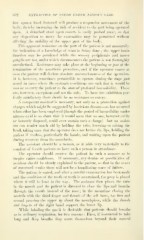Page 634 - My FlipBook
P. 634
(132 EXTRACTION OF TEETH UNDER NITROUS ON11).
l(('t ii|)()ii :i fixed footstool will produce a responsive movement of the
body, tlicrchy increasing the risk of accident to th(> j);irt being operated
upon. A detached stool upon casters is easily pushed away, so that
any disposition to move tiie extremities may he permitted without
ailectiug the stability of the up})er part of the body.
This apparent n^sistance on the part of the patient is not necessarily
the indication of a knowlcdox' of what is being done ; the upper brain
function may be paralyzed while tiie sensory ])eripherals and motor
ganglia are not, under which circumstances the patient is not thoroughly
anesthetized. Resistance may take place at the beginning or just at the
termination of the anesthetic procedure, and if the operator ceases at
once the patient will declare absolute unconsciousness of the operation.
It is, however, sometimes permissible to operate during the stage just
noted in cases where the systemic conditions are such that it would be
unwise to carry the patient to the state of profound insensibility. These
are, howev(!r, exceptions and not the rule. To have the exhibition per-
fectly satisfactory there should be no resistance or outcry.
A competent a><>
when ether has been employed (though the period of insensibility under
nitrous ox id is so short that it would seem that no one, however evilly
or honestly disposed, could ever sustain such a charge)—but an assist-
ant can render much aid by holding the tube, lowering or raising the
head, taking care that the operator does not bruise the lips, holding the
patient if restless, particularly the hands, and waiting upon the patient
during recovery from the anesthetic.
The assistant should be a woman, as it adds very materially to the
comfort of female ])atients to have such a person in attendance.
The operator should receive the patient in such a manner as to
inspire entire confidence. If necessary, any doubts or possibilities of
accident should be clearly explained to the ]iatient, so that in the event
of untoward results there will not be a humiliating sense of failure.
The patient is seated, and after a careful examination has been made
and the condition of the tooth or teeth is ascertained, the prop is placed
where it will be least in the way. The assistant then places the tube
in the mouth and the patient is directed to close the lips and breathe
through the mouth instead of the nose ; in the meantime closing the
nostrils with the third finger and thumb of the left hand, the first and
second pressing the upper lip about the mouthpiece, while the thumb
and fingers of the right hand support the lower lip.
While inhaling the gas it is desirable that patients should breathe
as in ordinary respiration, for two reasons : First, if instructed to take
long and deep breaths they exert themselves beyond their natural


